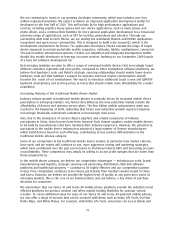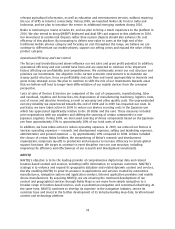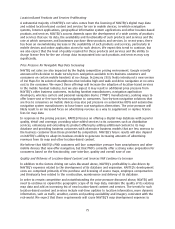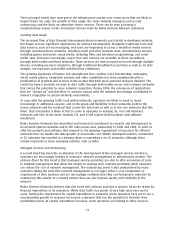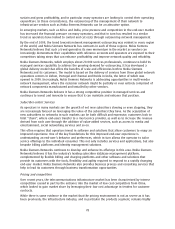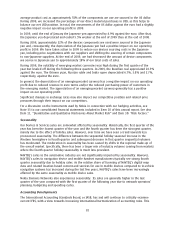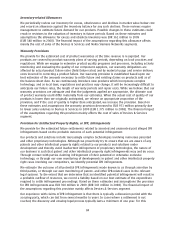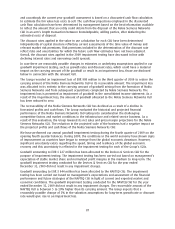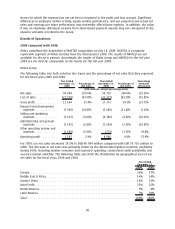Nokia 2009 Annual Report Download - page 82
Download and view the complete annual report
Please find page 82 of the 2009 Nokia annual report below. You can navigate through the pages in the report by either clicking on the pages listed below, or by using the keyword search tool below to find specific information within the annual report.Siemens Networks began implementing the restructuring in March 2010 by, for instance, initiating
consultations with local employee representatives in affected countries, including Finland and
Germany.
Nokia Siemens Networks plans to pursue acquisitions when assets are available and the associated
purchase price of those assets provides the appropriate value. In particular, assets that enhance the
scale of existing product and service business lines and that deepen relationships with key customers
may be targeted.
Certain Other Factors
Exchange Rates
Our business and results of operations are from time to time affected by changes in exchange rates,
particularly between the euro, our reporting currency, and other currencies such as the US dollar, the
Japanese yen and the Chinese yuan. See Item 3A “Selected Financial Data — Exchange Rate Data.”
Foreign currency denominated assets and liabilities, together with highly probable purchase and sale
commitments, give rise to foreign exchange exposure.
The magnitude of foreign exchange exposures changes over time as a function of our presence in
different markets and the prevalent currencies used for transactions in those markets. The majority of
our noneuro based sales are denominated in the US dollar, but Nokia’s strong presence in emerging
markets like China, India, Brazil and in Russia also gives rise to substantial foreign exchange exposure
in the Chinese yuan, Indian rupee, Brazilian real and Russian ruble. The majority of our noneuro
based purchases are denominated in US dollars and Japanese yen. In general, depreciation of another
currency relative to the euro has an adverse effect on our sales and operating profit, while
appreciation of another currency relative to the euro has a positive effect, with the exception of the
Japanese yen, being the only significant foreign currency in which we have more purchases than
sales.
In addition to foreign exchange risk of our own sales and cost, our overall risk depends on the
competitive environment in our industry and the foreign exchange exposures of our competitors.
To mitigate the impact of changes in exchange rates on net sales as well as average product cost, we
hedge material transaction exposures on a gross basis, unless hedging would be uneconomical due to
market liquidity and/or hedging cost. Nokia hedges significant forecasted cash flows typically with a 6
to 12 month hedging horizon. For the majority of these hedges hedge accounting is applied to reduce
profit and loss volatility. Nokia also hedges significant balance sheet exposures. Our balance sheet is
also affected by the translation into euro for financial reporting purposes of the shareholders’ equity
of our foreign subsidiaries that are denominated in currencies other than the euro. In general, this
translation increases our shareholders’ equity when the euro depreciates, and affects shareholders’
equity adversely when the euro appreciates against the relevant other currencies (yearend rate to
previous yearend rate). To mitigate the impact to shareholders’ equity, Nokia hedges selected net
investment exposures from time to time.
During 2009, the volatility of the currency market decreased gradually after the first quarter of the
year but remained elevated compared to levels during the first half of 2008. At the same time, the
currency market liquidity conditions improved after the first quarter of 2009, especially compared to
the second half of 2008. Overall hedging costs decreased during 2009 due to the low interest rate
environment and declining currency market volatility.
In 2009, until the end of February the US dollar appreciated against the euro by 6.0%. After that, the
US dollar depreciated by 12.0% and at the end of 2009 was 6.6% weaker than at the end of 2008.
The weaker US dollar towards the end of 2009 had a negative impact on our net sales expressed in
euro as approximately 45% of our net sales are generated in US dollars and currencies closely
following the US dollar. However, the depreciation of the US dollar also contributed to a lower
80





